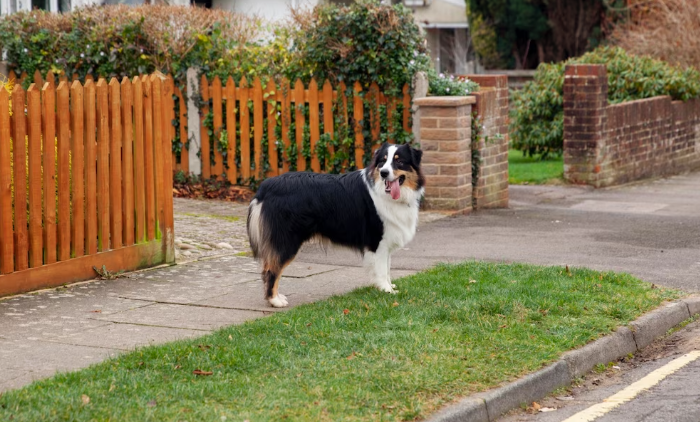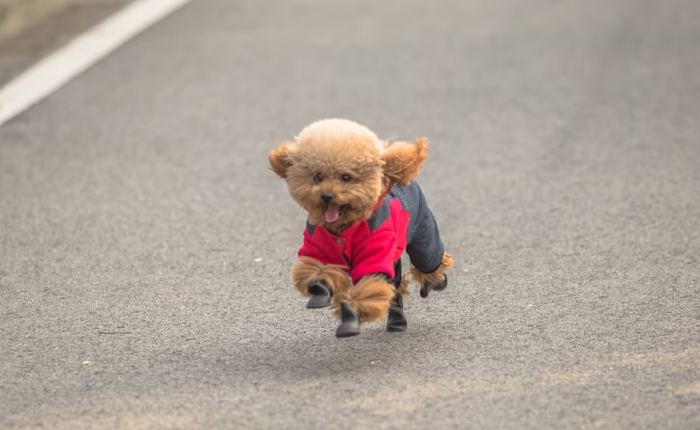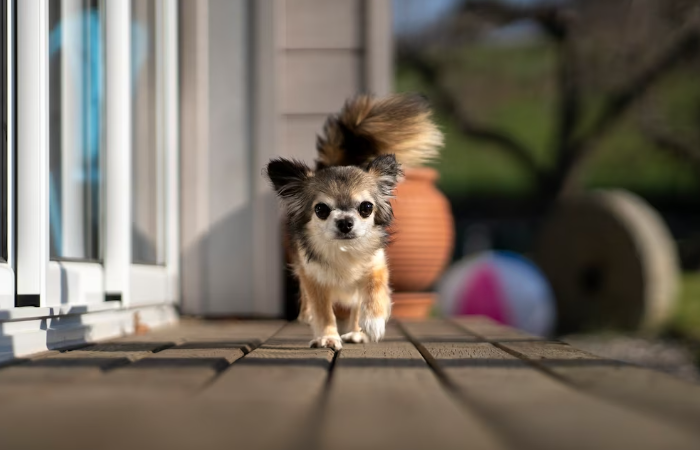2024-01-08
As dog owners, we may face different challenges while raising our beloved pet companions. Jumping on people or other dogs, barking, whining when left alone, pulling on a leash...there is a long list of potential issues that a canine can exhibit.
Luckily, some of these issues are common for pups only and they manage to outgrow them. Others, on the other hand, need our intervention as responsible owners, who want to ensure that their paw friends are safe, secure, and well-mannered.
Running out the door and being exposed to potentially dangerous situations such as being hit by a vehicle, is a behavioral issue that makes many dog parents genuinely worry about their furry friends.
The well-being and safety of our dogs are our utmost priority as caring pet parents, which is why this type of behavioral issue needs to be properly addressed.
In order to do that we need to know our paw friends as individuals and be able to determine the cause of this behavior. Then we need to take adequate action.

Dogs are inquisitive creatures, who enjoy exploring their surroundings, mainly by using their great sense of smell. Dogs at a young age are more likely to be overly curious and to want to explore every corner of their living environment- all the places, smells, animals, etc. Things outside may be far more interesting to a growing pup, than the familiar surrounding indoors.
Pups are not only more likely to show extensive interest in their surrounding but tend to be far more energetic than adult dogs. However, the dogs of some breeds such as the Golden Retriever, often remain as active as adults as they were as pups.
If you are raising a canine, who is fast and energetic like a fireball, then running outside is likely to be an issue you will have to deal with.
For a dog who is not socialized and trained, the exposure to the variety of stimuli that the outside world offers may be overwhelming. These can be sights, smells, sounds, places, objects, people, animals…
Our paw friends may be highly triggered by certain stimuli, which can cause them to run out to thoroughly investigate them. Alternatively, some of these stimuli may startle our paw friends, and make them want to hide.

Do not let your paw friend get bored at home. By keeping them engaged in interesting games, i.e. solving puzzles, chasing a ball, finding hidden treats, searching for toys, playing tug of war, etc. you will reduce the chance of your dog wanting to run out.
Providing your canine with interesting toys and engaging in play sessions with them will help you keep them physically and mentally stimulated and strengthen your bond with them.
Being able to spend their energy will make your dog happier and less eager to excessively explore outside. Not to mention, that a tired dog is not likely to want to run out.
Environmental modifications refer to the changes in the physical environment of your paw friend that you can and may need to make.
Installing baby gates or exercise pens may be a good (temporary) solution to the problem. These types of equipment will help create a designated area for your dog and will physically prevent them from accessing the door and running out.
Using a screen door or a storm door may not only protect your primary door and stop insects or birds from getting inside but can be very helpful to prevent your dog from running outside. These doors will play the role of an extra layer of protection, in case your paw friend manages to overcome the first one.
Attaching a leash to your dog’s collar or eventually practicing tether training with them, will help you properly handle them when opening the front door.
Please, be careful, when you physically restrict your dog from running out. It is important that you create a positive association with the leash and all the restrictive devices you may decide to utilize.
You should give your dog time to get used to the leash prior to putting it on them. Do not forget to praise and reward your paw friend for being calm and well-mannered when being on a leash or otherwise tethered. Also, it is essential that you always supervise your canine if they are tethered at home. Do not leave them unattended for a long time.
Physically restricting your dog may “cure the symptoms” but won’t solve the problem…
It is proper training that you need to teach your dog to not run out the door.
Basic obedience training such as ‘sit’, ‘wait’, and ‘recall’ are crucial for a dog to be well-mannered and able to control their impulses.
By applying positive reinforcement, you are helping your dog stay motivated, which will have a positive impact on the training process!
Teaching basic obedience commands is easier than it may look! All you need is a quiet area at home and your paw friend’s favorite treats.
Sit
Wave a treat in front of your dog’s head by slowly moving it above. Your dog may want to keep the treat within their sight and end up in a sitting position. The moment your paw friend’s bottom touches the ground you should click (if you use a clicker during the training) and give your dog the treat.
Repeat these steps as many times as needed until your dog starts showing the behavior consistently. Then you can replace the clicker with a vocal cue such as “sit”.
Wait
The “wait” command can be perceived as a long “sit”, so the beginning of the training session is the same- you should go to a quiet room and lure your dog into a sitting position using their favorite treats.
The easiest way to train a dog to wait is to use their food bowl. Gradually move it towards the floor by observing your dog and making sure that they do not immediately rush towards the bowl. If your paw friend remains calm and does not come to the bowl, you can praise and reward them.
If your canine tries to reach the bowl, you should move the bowl back to you and repeat the steps. Repeat as many times as needed, until your dog learns to go the food bowl only after you allow them to do it.
You should practice the steps several times a day by gradually extending the period of time your paw friend needs to wait for your permission.
Remember to keep each session no longer than 10 minutes. Otherwise, your dog may be unable to remain focused on the tasks and the chances are that they get bored.
Recall
What is the easiest way to train a dog to recognize their name? To make them associate it with something positive, of course!
Prepare treats or your paw friend’s food bowl and stay near them while having them on a leash. Call your canine by name and immediately offer treats / small amounts of their food. Repeat these steps several times by being patient and waiting for your paw friend to come to you.
You need to practice this until your dog starts coming towards you the moment they hear their name. Training should always start in a quiet area without distractions. Once the dog can respond on a regular basis, you can start adding distractions such as moving to a noisier room, your garden, a local park, etc.
Extensive obedience includes a wide range of commands such as “look at me/watch me”, which is essential in focus training, “leave”, “go to your spot”, “down”, etc.
The level of training you want your paw friend to reach depends on different factors such as if there are behavioral issues you need to address; if you want to prepare your dog to pass certain training tests and be certified, such as the Canine Good Citizen Course by the American Kennel Club; if you consider training your dog in advanced tasks as a service animal, etc.

If your paw friend is triggered by specific stimuli outdoors, you need to identify these and work on desensitizing their effect on your dog. In order to accomplish that, you need to start gradually exposing your canine to these stimuli. You should make sure in the beginning that their intensity is at a very low level- so low that there is no reaction from your dog.
For example, if your dog is triggered by the view of cats walking outside, you can start by showing them a photo or a video of cats. Remember to keep a long distance at the beginning.
If your dog remains calm and there is no reaction, you should praise them and feed them their favorite treats. This process is known as ‘counter-conditioning’, as it is aimed at changing the dog’s attitude towards the stimuli from negative to positive.
You should reduce the distance step by step by never forgetting to reward your pet companion for being calm and well-mannered. If you notice that they start reacting, you should stop the session for a few minutes, until your dog calms down, increase the distance and start again.
After enough repetitions, your dog should be able to tolerate the presence of the stimuli and be less willing to run outside because of them.
Consistency is key when addressing behavioral issues. It is important, that everyone in your household follows the same rules and techniques. Additionally, manage your dog's environment to minimize the temptations that trigger the running-out behavior. For example, keep your dog in a separate room or crate during busy times when the door is frequently used and they are not properly trained yet.
Preventing your dog from running out the door requires patience, consistency, and finding the right approach. By understanding your dog's behavior, implementing effective training techniques, and making necessary environmental modifications, you can ensure that your dog is safe and that the risk of accidents is minimized.
Remember to always reward your paw family member when showing the wanted behavior, and practice regularly. By investing time and effort, you can help your pup become a well-behaved, dog who can be safe and secure within your home.